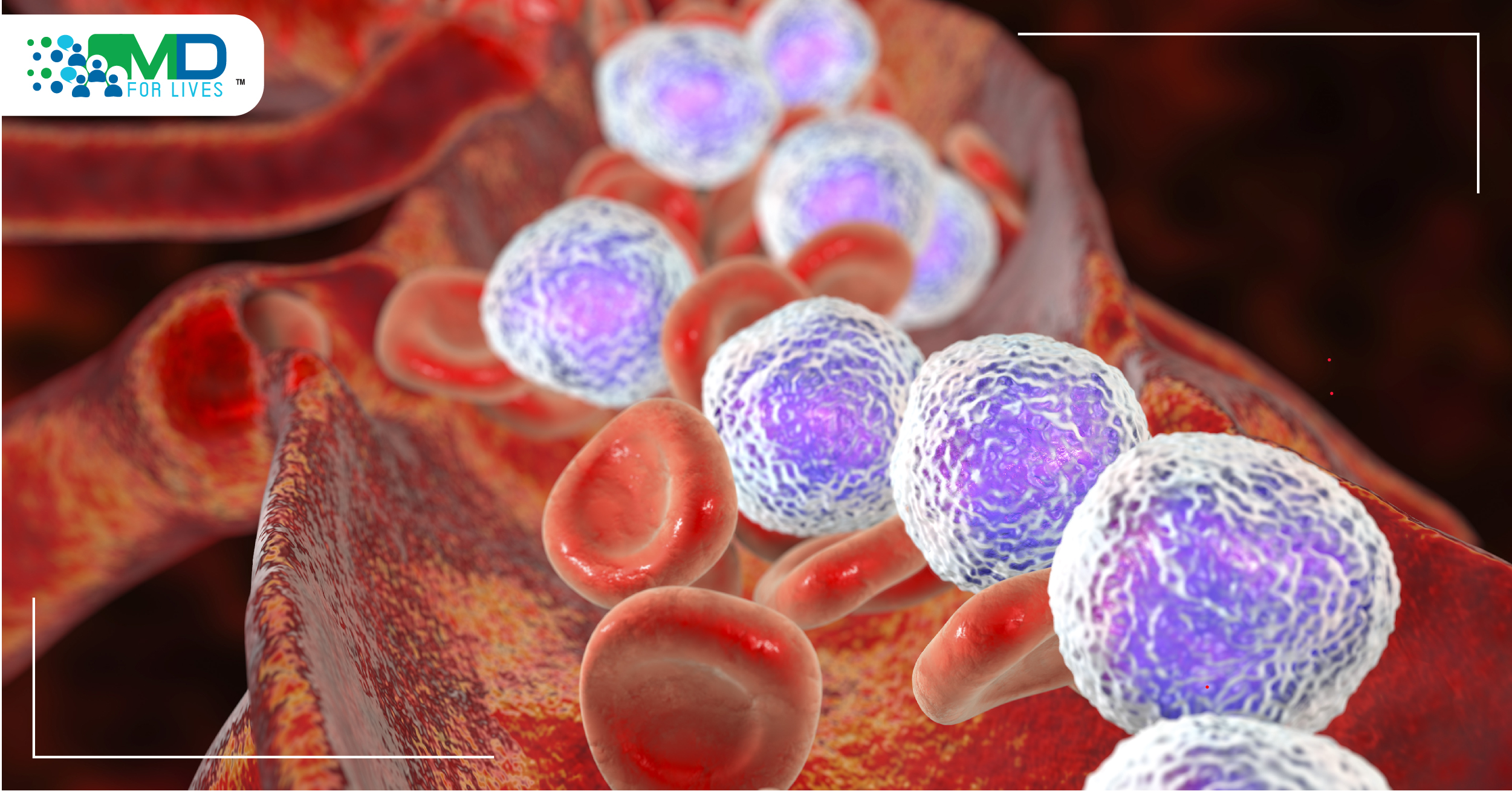Hematological cancers were among the first to be discovered to have abnormal demethylation status. Excretion of epigenetic DNA modification in the urine of children may be a reliable marker of chemotherapy response and a marker of the pediatric acute lymphoblastic leukemia (ALL) status.

Acute lymphoblastic leukemia is a cancer of the blood and bone marrow. In childhood acute lymphoblastic leukemia (ALL), the bone marrow makes too many immature lymphocytes. Genome-wide analyses of leukemic and normal host cells continue to provide new insights into leukemogenesis.
DNA methylation is one of the most studied epigenetic modifications and is essential for mammalian development. DNA methylation is removed through the process of demethylation, which can occur both passively and actively, with 5-hydroxymethylcytosine (5hmC) being a measurable intermediate of one of the active demethylation pathways. The mammalian DNA methylome is formed by two antagonizing processes, methylation by DNA methyltransferases (DNMT) and demethylation by ten-eleven translocation (TET) dioxygenases. TET inactivation is involved in the deregulation of hematopoiesis and triggers blood cancers.

ALL can arise from any lymphoid cell that is blocked at a specific stage of development and usually begins in a single B- or T-lymphocyte progenitor. The majority of ALL patients have genetic abnormalities. It is possible that abnormal DNA methylation causes changes in the expression of hematopoietic genes. There is also a difference observed in the pattern of cytosine methylation in leukemic cells and nonleukemic cells.
Active DNA demethylation is associated with abnormal methylation and may play a role in leukemogenesis. The DNA demethylation process in acute lymphoblastic leukemia involves the following process:
Enzymatic oxidation of 5-methylcytosine by TET forms 5-hydroxymethylcytosine, which is then oxidized to 5-formylcytosine and 5-carboxylcytosine. TET may release 5-hydroxymethyluracil. TET enzymes with thymine DNA glycosylase (TDG) aid in the active demethylation of DNA. TDG is a base excision repair (BER) enzyme that removes 5-formylcytosine and 5- carboxylcytosine to help in the active DNA demethylation process. By the BER pathway, 5- hydroxymethyluracil is also removed. Into the bloodstream, the bases that are eliminated are released and then appear in the urine.
Figure 3: Schematic illustration of methylation and active demethylation pathways.
New research by Rozalski et al., 2021, aimed to study if the products of the active DNA demethylation process and oxidative stress (DNA – 8-oxo-7,8-dihydro-2′-deoxyguanosine as an established marker of oxidative stress) may serve as biomarkers to assess the status of ALL. The concentration of ascorbate was also analyzed, which is involved in the active demethylation process as a TET cofactor. The expression of TET and TDG at the mRNA and protein levels was determined.
To analyze the level of 5-methylcytosine, 5-hydroxymethylcytosine, 5-formylcytosine, and 5- carboxylcytosine in the urine and blood, a rapid, highly sensitive and specific isotope-dilution automated two-dimensional ultra-performance liquid chromatography with tandem mass spectrometry (2D-UPLC–MS/MS) method was be used. The level of 5-(hydroxymethyl)-2′- deoxycytidine is much higher than the levels of the other forms of modified DNA, which affects the detection and quantitation of 5-methylcytosine, 5-hydroxymethylcytosine, 5-formylcytosine, and 5-carboxylcytosine, and to deal with this issue, 2D-UPLC–MS/MS was used.
At three time points, samples were collected from newly diagnosed acute lymphoblastic leukemia pediatric patients: before treatment began (point A- peripheral blood and urine), 33 days after the initiation of the treatment (point B- peripheral blood and urine), and 6 months later (point C- urine only). The ALL patients were divided based on the disease subtype (B and T type, i.e., B-ALL and T-ALL). Control samples were obtained from healthy donors. 2D UPLC– MS/MS was used for the epigenetic modification analysis of urine samples, with an exception of 5-hydroxymethylcytosine. High-performance liquid chromatography for prepurification followed by gas chromatography with isotope dilution mass spectrometric detection (LC/GC– MS) was used to determine the level of 5-hydroxymethylcytosine. Ascorbate levels in the blood
plasma were determined by ultra performance liquid chromatography coupled with UV/visible spectrophotometry (UPLC‑UV).
Before the initiation of the treatment, ALL patients had significantly higher levels of analyzed modifications in their urine than controls did. Both 33 days after starting the treatment (point B) and 6 months later (point C), the patients’ active demethylation products (i.e., 5- methylcytosine, 5-hydroxymethylcytosine, 5-formylcytosine, and 5-carboxylcytosine) in the urine decreased statistically significantly. When analyzed at 6 months, both the control group and ALL group had a similar level of the tested product. The level of 5-(hydroxymethyl)-2′- deoxycytidine (5-hmdC) in the DNA of leukocytes in the blood of the patient group was significantly lower than that of the control group. The most common chromosomal abnormality in children with B-ALL is an ETV6/RUNX1 gene fusion caused by t(12;21)(p13;q22), and ETV6/RUNX1-positive ALL patients had significantly higher levels of the analyzed modifications in their urine than ETV6/RUNX1-negative ALL patients. In the case of TET and TDG mRNA expression, the expression of TET1 mRNA was higher and the expression of TET2 mRNA and TET3 mRNA was lower in the ALL group. TDG mRNA expression also had a statistically significant difference between both groups. Plasma concentrations of ascorbate in the ALL patients were lower than those in the controls, and the 8-oxodG concentration was higher in the ALL group in both the urine and cellular DNA.
Table 1: Urinary levels of DNA damage markers and active demethylation products of 5- methylcytosine
Figure 4. Plasma concentrations of ascorbate in the ALL and control group
The urinary excretion rates of the majority of the DNA epigenetic modifications were significantly higher in the patient group than in the healthy group. After the patients finished chemotherapy, there was a significant decrease in the levels of these modifications in their urine compared to the levels observed in the urine of healthy subjects. Both 5-formylcytosine and 5- carboxylcytosine may inhibit DNA replication, resulting in genome instability, and hence, in the removal of modifications from DNA, effective enzymatic systems are involved. The activity of TET and TDG may contribute to the presence of modified bases in the urine. The excretion of epigenetic DNA modification into urine is equal to the rate of active demethylation of DNA. Ascorbic acid (AA) enhances the activity of TETs and the ALL patients analyzed in our study had significantly lower serum AA concentrations, indicating that a factor that influences the activity of TET proteins is ascorbic acid.
The study clearly shows that the urinary excretion of epigenetically modified DNA may be a reliable marker to check the ALL status and chemotherapy response. The detection of epigenetic DNA modifications in human urine could be a promising noninvasive diagnostic option for ALL status and chemotherapy response. The urinary excretion rates discovered in this study for the control group/healthy children were comparable to those discovered in healthy adults.

- https://www.frontiersin.org/articles/10.3389/fgene.2020.00452/full
- https://www.ncbi.nlm.nih.gov/pmc/articles/PMC4741426/
- https://www.nature.com/articles/s41467-021-25521-7
- https://www.nature.com/articles/s41598-021-00880-9






